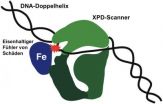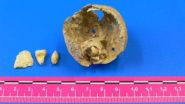(Press-News.org) An insect with a tiny brain and minimal computing power has become the first animal proven to use the Milky Way for orientation. Scientists from South Africa and Sweden have published findings showing the link between dung beetles and the spray of stars which comprises our galaxy.
Although their eyes are too weak to distinguish individual constellations, dung beetles use the gradient of light to dark provided by the Milky Way to ensure they keep rolling their balls in a straight line and don't circle back to competitors at the dung pile.
"The dung beetles don't care which direction they're going in; they just need to get away from the bun fight at the poo pile," said Professor Marcus Byrne from Wits University.
Byrne and his team previously proved that dung beetles use the sun, the moon and polarised light for orientation. In their experiments, they gave the beetles "caps" which blocked light from reaching their eyes. The team also discovered that the beetles climb on top of their dung balls to perform an orientation "dance" during which they locate light sources to use for orientation.
Now, further experiments, conducted under the simulated night sky of the Wits Planetarium, have shown that the beetles also use the Mohawk of the Milky Way – giving new meaning to dancing with the stars!
"We were sitting out in Vryburg (conducting experiments) and the Milky Way was this massive light source. We thought they have to be able to use this – they just have to!" said Byrne.
Not all light sources are equally useful landmarks for a dung beetle. A moth keeping a constant angle between itself and a candle flame will move in a circle around the flame. However, a celestial body is too far away to change position relative to a dung beetle as it rolls its ball, with the result that the beetle keeps travelling in a straight line.
The scientists suspect the beetles have a hierarchy of preference when it comes to available light sources. So if the moon and the Milky Way are visible at the same time, the beetles probably use one rather than the other.
A few other animals have been proven to use stars for orientation, but the dung beetle is the first animal proven to use the galaxy.
INFORMATION:
Dung beetles use stars for orientation
2013-01-24
ELSE PRESS RELEASES FROM THIS DATE:
Discovering the secrets of tumor growth
2013-01-24
Scientists at the University of Copenhagen's Center for Healthy Ageing have identified a compound that blocks the expression of a protein without which certain tumours cannot grow. This compound has the potential as an anticancer agent according to the research published in the journal CHBIOL: Chemistry and Biology this week.
The BLM protein is also known to be important in maintaining stability in cells when they multiply, thus preventing cancer. However, certain types of tumour need BLM to grow. This is typical of osteosarcomas - aggressive malignant tumours often seen ...
A scanner for hereditary defects
2013-01-24
Our DNA is constantly under attack from UV light, toxins and metabolic processes. Proteins and enzymes continually repair the damaged DNA. Unrecognized and therefore unrepaired damage to the genetic material, however, accelerates aging and causes cancer and genetic disorders. A team headed by veterinary pharmacologist and toxicologist Hanspeter Nägeli has now discovered that the protein XPD plays a key role in locating damaged DNA.
XPD protein as scanner
Genetic information is stored on approximately three billion base pairs of adenine/thymine or cytosine/guanine in ...
Research ties lightning to onset of headache, migraines
2013-01-24
CINCINNATI—University of Cincinnati (UC) researchers have found that lightning may affect the onset of headache and migraines.
These results, published in the Jan. 24, 2013 online edition of the journal Cephalalgia, are the first tying lightning to headache and could help chronic sufferers more efficiently anticipate headache and migraine arrival and begin preventive treatment immediately.
Geoffrey Martin, fourth-year medical student at UC, and his father Vincent Martin, MD, professor in the division of general internal medicine, UC Health physician and headache expert, ...
False beliefs persist, even after instant online corrections
2013-01-24
COLUMBUS, Ohio - It seems like a great idea: Provide instant corrections to web-surfers when they run across obviously false information on the Internet.
But a new study suggests that this type of tool may not be a panacea for dispelling inaccurate beliefs, particularly among people who already want to believe the falsehood.
"Real-time corrections do have some positive effect, but it is mostly with people who were predisposed to reject the false claim anyway," said R. Kelly Garrett, lead author of the study and assistant professor of communication at Ohio State University.
"The ...
Liquid crystal's chaotic inner dynamics
2013-01-24
Liquid crystal displays are ubiquitous. Now, Polish physicists have demonstrated that the application of a very strong alternating electric field to thin liquid crystal cells leads to a new distinct dynamic effect in the response of the cells. The theory of spatio-temporal chaos explains this effect. It was elucidated by Wojciech Jeżewski and colleagues from the Institute of Molecular Physics, Polish Academy of Sciences, in Poznań, Poland, and is about to be published in EPJ E. This effect has implications for the operation of liquid-crystal devices because their ...
Adolescent sexual and reproductive health priorities identified
2013-01-24
Quality sexual and reproductive health care is an essential component of public health. However, there are insufficient evidence-based policies related to adolescent sexual and reproductive health in low- and middle-income countries. In an effort to address the research gap, faculty from the Johns Hopkins Bloomberg School of Public Health led a project to identify research priorities for adolescent sexual and reproductive health in these countries. The results, which are based on input from nearly 300 experts and highlight key focus areas, are featured in the January issue ...
Some minority students may fare better than whites when working part time, new research finds
2013-01-24
WASHINGTON - African-American and Hispanic students may be less likely than non-Hispanic white students to hold a job during the school year, but when they do, they tend to work somewhat longer hours and seem less likely to see their grades suffer than non-Hispanic white students with jobs, according to new research published by the American Psychological Association.
A study involving nearly 600,000 students from around the country also found that among high school students who work long hours at a part-time job, black and Hispanic students from lower income households ...
Researchers uncover gene's role in rheumatoid arthritis, findings pave way for new treatments
2013-01-24
ANN ARBOR, Mich. — University of Michigan research sheds new light on why certain people are more likely to suffer from rheumatoid arthritis – paving the way to explore new treatments for both arthritis and other autoimmune diseases.
The new UMHS research in mice identifies how a specific group of genes works behind the scenes to activate the bone-destroying cells that cause severe rheumatoid arthritis, a debilitating health issue for millions of Americans.
"We believe this could be a significant breakthrough in our understanding of why certain genes are associated ...
Climate change beliefs of independent voters shift with the weather, UNH study finds
2013-01-24
DURHAM, N.H. – There's a well-known saying in New England that if you don't like the weather here, wait a minute. When it comes to independent voters, those weather changes can just as quickly shift beliefs about climate change.
New research from the University of New Hampshire finds that the climate change beliefs of independent voters are dramatically swayed by short-term weather conditions. The research was conducted by Lawrence Hamilton, professor of sociology and senior fellow at the Carsey Institute, and Mary Stampone, assistant professor of geography and the New ...
Ovarian tumor, with teeth and a bone fragment inside, found in a Roman-age skeleton
2013-01-24
A team of researchers led by the UAB has found the first ancient remains of a calcified ovarian teratoma, in the pelvis of the skeleton of a woman from the Roman era. The find confirms the presence in antiquity of this type of tumour - formed by the remains of tissues or organs, which are difficult to locate during the examination of ancient remains. Inside the small round mass, four teeth and a small piece of bone were found.
Teratomas are usually benign and contain remains of organic material, such as hair, teeth, bones and other tissues. There are no references in the ...



